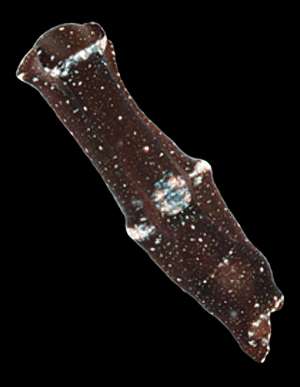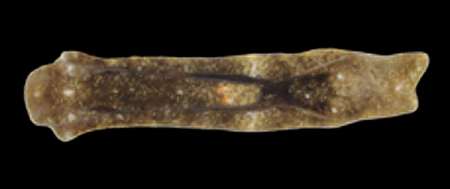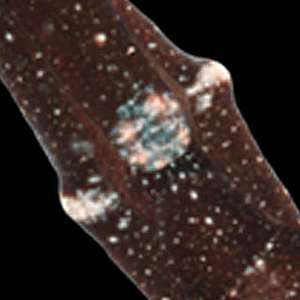Philinopsis aeci from the Bahamas
January 8, 2004
From: Colin Redfern

Dear Bill,
I was very interested to see Anne DuPont's photos of this species, and to read your comments regarding Philinopsis aeci. I've collected two more specimens from Abaco during the past couple of years, and thought that the attached photo of a dark brown 9mm animal might be helpful. In some ways it perhaps bridges the gap between Anne's specimen and the one photographed by Ortea & Espinosa. Interestingly, there is a group of four or five reddish orange spots at the rear of the head shield, and a few less conspicuous ones elsewhere. Also attached is a photo of a much smaller, more yellowish animal. If I have correctly identified this as a juvenile of the same species, it shows that the white transverse bands may sometimes consist of little more than a few white spots. This specimen also has a couple of reddish orange spots towards the rear of the head shield.
Upper Photo: 9mm. Live on Cladophora in 1m, Thurstone Bay, Abaco, Bahamas. August 18, 2002.
Lower Photo: 2.75mm. Live on Sargassum attached to the substrate in 0.6m. Guana Cay, Abaco, Bahamas. August 12, 2003.
Best wishes,
Colin
bahamianseashells@att.net
![]()


Thanks Colin,
In my comments on Anne Dupont's message I said what we needed were more photos and in two days we have them! Thanks very much. The reddish tubercles in the larger of your two animals certainly link the Bahamian animals with the original specimens from Costa Rica. Interestingly, as I said before, similar tubercles are associated with the whitish transverse bands in the Indo-West Pacific species Aglaja? orientalis.
Both these animals are dark brown, like Ortea & Espinosa's original photo, while the photos in your book, although with prominent white transverse bands, are much lighter, as in Anne Dupont's animals. These new photos of yours are indeed a valuable addition, clearly linking Anne's animals and those of Ortea & Espinosa.
Best wishes
Bill Rudman
Related messages
-
Philinopsis aeci? from St. Vincent, Caribbean
From: Les Wilk, January 13, 2006 -
Colour variation in Philinopsis aeci
From: Anne DuPont, August 29, 2005 -
Philinopsis aeci from the Bahamas
From: Anne DuPont, January 6, 2004
